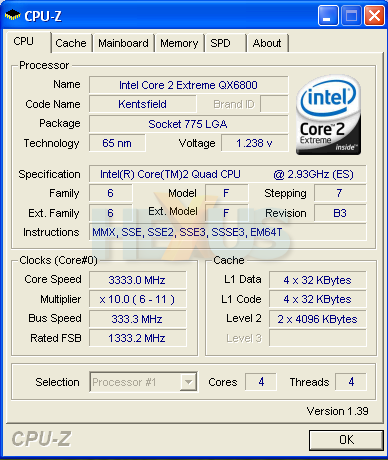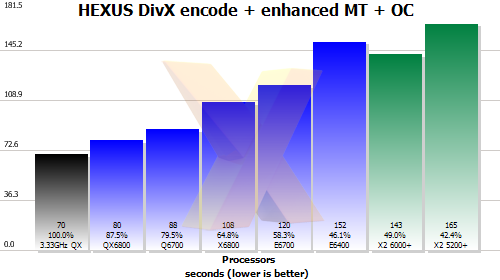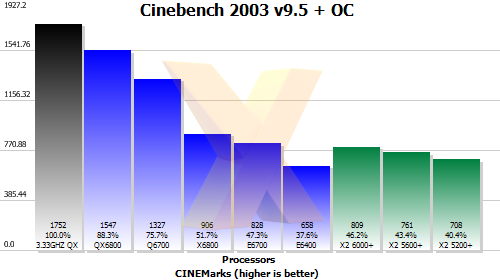Overclocking and power consumption
The processor is mighty quick at its default speed but it never hurts to evaluate just how high it will go. Stable, overclocked figures give us an indication of just where Intel's yields are currently at, and a precursor of what to expect in the coming months.
We raised the CPU voltage from the default 1.35V to 1.375V and continued to use the reference heatsink. We're adamant that enthusiasts with esoteric cooling will push their QX6800s further.

Taking on enthusiast thinking we dropped the multiplier and raised the FSB to a portentous 1333MHz QDR, giving us an overall speed of 3333MHz. Associated memory speeds and timings changed slightly, too, from DDR2-800 to DDR2-833.2.
Our DivX encode, Cinebench, and Quake 4 benchmarks were re-run with the overclocked QX, sporting all the threes, denoted in black.


The numbers speak for themselves; the fast gets faster.

Quake 4 has been included to show that applications whose performance is dictated by other factors (graphics cards) won't scale as well, obviously.
Power consumption
Both processor firms adopt different methods when calculating thermal design power (TDP). Rather than isolate the CPU by itself, which is rather tricky, we've benchmarked the idle and peak wattage requirement for the platforms as a whole, as per our specification page.Peak load refers to running 3DMark05, at 1920x1200 4xAA 8xAF, on one core and concurrently running the Prime95 torture test on all other available cores. For a dual-core processor, then, that's the second core, and for the quad-core models that relates to three remaining cores.
We've noted PSU efficiency as 82 per cent and the following graph represents the power required by the system once this has been factored in to the watt meter reading that produces an at-socket figure.

The idle wattage represents the processors using SpeedStep/Cool 'n' Quiet technologies. The load figure is for the system and includes a Radeon X1900 XTX running at full chat. However, we can still discern that, ceteris paribus, Intel's dual-core X6800 uses around 65W less than the other three CPUs when running under load.
65nm technology has allowed Intel to ship a 582m transistor quad-core processor that's significantly faster than the AMD Athlon 64 X2 6000+ in most truly multi-threaded scenarios, but one that still fits into the same thermal envelope.









